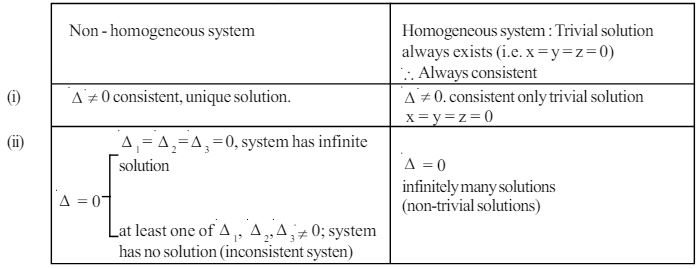Matrices And Determinants - Properties and Evaluation of Determinants (Lecture-01)
DETERMINANTS
Minors & cofactors of elements of a determinant.
It we delete the row and column passing through the element
Note :
If all the elements in a row (or column), except one element, are zeros the determinant reduces to a determinant of an order less by one.
Also a determinant can be replaced by a determinant of higher order by one.
Eg:
Singular or non singular matrix :
A square matrix A is said to be non-singular if
Properties of determinants
For a square matrix A,
(i) If a row (column) is a zero vector, then
(ii) If any two rows (columns) are proportional, then
(iii) If the rows & columns are interchanged, then
(iv) If any two rows (columns) are interchanged, value of
(v)
(vi) If A is a square matrix of order
(vii)
(viii) If a scalar multiple of any row (column) is added to another row (column) then
i.e.
(ix) The sum of the products of elements of any row (column) of a determinant with the cofactors of the corresponding elements of any other row (column) is zero
If, A =
(x) The sum of the products of elements of any row (or column) of a determinant with the cofactors of the corresponding elements of same row is
i.e.
(xi) If r rows (columns) become identical when ’
Put
(xii) If
(xiii)
(xiv) Let
(xv) Product of determinants of same order
Multiplication can also be performed row by column ; column by row or column by column as required in the problem.
(xvi)
(xvii) Determinant of a skew symmetric matrix of odd order is zero
Use of Determinants :
(i) Area of triangle whose vertices are
(ii) If
(ii)
Cramer’s rule for solving simultaneous linear equations
Consider the system of equations
Here
By cramer’s rule,
In the above system, if

Solved Examples
1. The value of the determinant
(a) 0
(b) 1
(c)
(d) None of these
Show Answer
None of these
Solution :
We can write the given determinant as the product of two determinants
Answer: (a)
2. If
is equal to
(a) 1
(b) 2
(c) 4
(d) 8
Show Answer
Solution :
The given determinant can be written as
Answer: (b)
3. If the value of determinant
(a) abc
(b) abc
(c) abc
(d)
Show Answer
Solution :
Answer: (b)
4. If
(a)
(b)
(c) 1
(d) None of these
Show Answer
Solution :
Let
Solution :
Answer: (d)
5. If
(a)
(b)
(c)
(d) None of these
Show Answer
Solution :
Apply
Answer: (a)
Exercise
1. If
(a) 4
(b) 6
(c) 8
(d) 10
Show Answer
Answer: d2. If
(a) 1
(b) -1
(c)
(d) 0
Show Answer
Answer: d3. If
(a)
(b)
(c)
(d) 0
Show Answer
Answer: d4. A triangle has vertices
(a) the medians for triangle
(b) the triangle
(b) the triangle
(b) altitudes of the triangle
Show Answer
Answer: d5. Let
(a)
(b)
(c)
(d) None of these
Show Answer
Answer: b6. If the value of
(a) any even integer
(b) any odd integer
(c) any positive integer
(d) zero
Show Answer
Answer: b7.
(a)
(b)
(c)
(d)
Show Answer
Answer: a8. Match the following :
| Column I | Column II | ||
|---|---|---|---|
| (a) | If |
(p) | 2 |
| then |
(q) | 4 | |
| (b) | If |
(r) | 1 |
| (c) | If |
(s) | 3 |
Show Answer
Answer:9. If
(a) 0
(c) 1
(b)
(d) None of these
Show Answer
Answer: a10.
(a) 0
(b) 1
(c) -1
(d) None of these
Show Answer
Answer: a11. Suppose
(i)
(ii) fhas minimum at
(iii) for all
(a) 0
(b) constant
(c)
(d) None of these
Show Answer
Answer: d12. Let
(i) The value of
(a)
(b)
(c)
(d) None of these
(ii) The value of
(a)
(b)
(c)
(d) None of these
(iii) If
(a)
(c)
(b)
(d) None of these
Show Answer
Answer: (i) b (ii) b (iii) c13. If
(a) -5
(b) -4
(c) -3
(d) -2
Show Answer
Answer: b14.* If
(a) graph of
(b) graph of
(c)
(d)
Show Answer
Answer: a, c15.* If
(a)
(c)
(b)
(d) None of these










